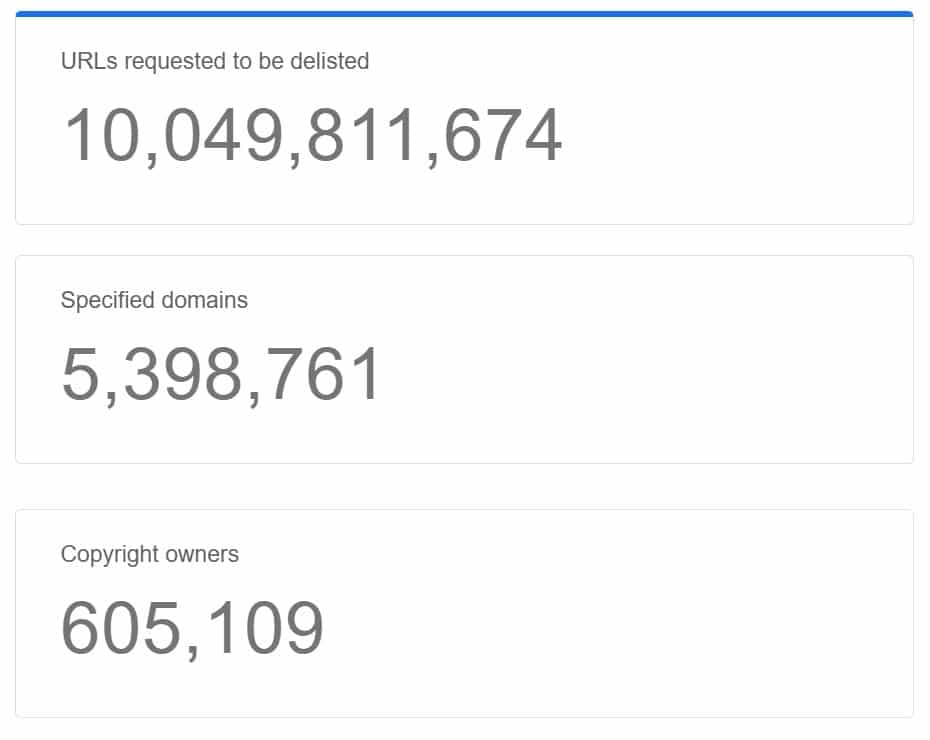Rightsholders have asked Google to remove more than 10 billion 'copyright infringing' URLs from its search results. The search engine doesn't celebrate the milestone in any way, but the takedown notices document intriguing shifts in volume over time, as well as shifting takedown interests.
While search engines are extremely helpful for the average Internet user, copyright holders have also seen a massive downside.
In addition to trillions of legitimate pages, there’s a steady supply of pirate sites. These can be hard to ignore for some entertainment-hungry users.
This problem is not new. When piracy-discovery became web-based with the surge of BitTorrent in the early 2000s, search engines were unwittingly used as pirate gateways. Luckily for rightsholders, however, U.S. law provided a solution; DMCA notices.
In the hope of steering prospective pirates away from pirate sites, copyright holders began sending DMCA takedown requests to Google. These notices flag pirate links, which Google then removes from its search index.
From Hundreds to 10 Billion
These requests have increased dramatically over the years and have just hit a new milestone. According to the official transparency report, Google search has now processed takedown requests for more than 10 billion URLs.

10 billion
The path to 10 billion was turbulent. When Google first made DMCA details public it was processing a few million DMCA takedown requests in a year. That number swiftly increased to hundreds of millions and eventually reached a billion DMCA requests in 2016.
The exponential growth curve eventually flattened out and around 2017, the takedown volume started to decline. The decrease was in part due to various anti-piracy algorithms making pirated content less visible in search results.
By downranking pirate sites, infringing content became harder to find. As a result, Google processed fewer takedown notices, a welcome change for both rightsholders and the search engine.
The Takedown Resurgence
Today, Google continues to make pirate sites less visible in search, but the reduction in takedown notices didn’t last. On the contrary, over the past several months, Google search processed a record number of DMCA notices.
Last summer, the search giant recorded the 7 billionth takedown request and after that the numbers shot up, adding billions more in the year that followed.
The company is now handling removal requests at a rate of roughly 2.5 billion per year; a new record. This represents more than 50 million takedown requests per week and roughly 5,000 every minute.

Google Search Takedown Notices (2012-2024)
The graph above illustrates how these numbers have grown over time, with the most recent uptick on the right.
The Content Shift
Aside from volume, there are significant changes in the targeted sites as well. Initially, torrent sites such as The Pirate Bay were frequently listed, but file-hosting services and streaming portals took over later, as these have many more indexed pages.
Studies published around 2013 showed that music companies were the most frequent senders. The labels and their representatives accounted for more than 40% of all takedown notices, followed by adult entertainment, and movie/TV rightsholders at a respectful distance.
At the time, the publishing industry accounted for less than 5% of all DMCA requests. The position is quite different today, as publishers are responsible for more than half of the URLs reported this year.
Faced with defiant pirate sites such as Z-Library and Anna’s Archive, publishers are clearly taking piracy more seriously than ever before. And in anti-piracy outfit Link-Busters, they have found a prolific takedown partner that meets their needs. That brings us to the outliers.
The Outliers
While the 10 billionth reported URL is undoubtedly a milestone, this number is largely driven by a few rightsholders, reporting outfits, and domain names. The aforementioned takedown outfit Link-Busters, for example, accounts for roughly 15% of all reported links, nearly 1.5 billion.
Similarly, the ten most prolific rightsholders, including the BPI, HarperCollins, and VIZ Media, are responsible for 40% of all reported links. These ten companies are only a tiny fraction of the 600,000 rightsholders that reported pirated links, however.

Top Rightsholders
A small group of domains also receives a disproportionate amount of attention. In total, 5,400,061 domains have been reported, with the top domains having dozens of millions of flagged URLs each. However, most domains have only a few flagged links, some of which are erroneous.
The WhiteHouse.gov domain name, for example, was reported 27 times. Google didn’t see any infringing material on the site, however, so none of these takedown requests were honored.
The overall number of URLs actually removed from Google search isn’t clear from Google’s transparency data. The 10 billion number includes links that were not removed by Google, as well as duplicate URLs, and those that were not indexed by Google at the time the takedown notice was received.
Hope you enjoyed this news post.
Thank you for appreciating my time and effort posting news every day for many years.
2023: Over 5,800 news posts | 2024 (till end of October): 4,832 news posts
RIP Matrix | Farewell my friend ![]()



3175x175(CURRENT).thumb.jpg.b05acc060982b36f5891ba728e6d953c.jpg)
Recommended Comments
There are no comments to display.
Join the conversation
You can post now and register later. If you have an account, sign in now to post with your account.
Note: Your post will require moderator approval before it will be visible.